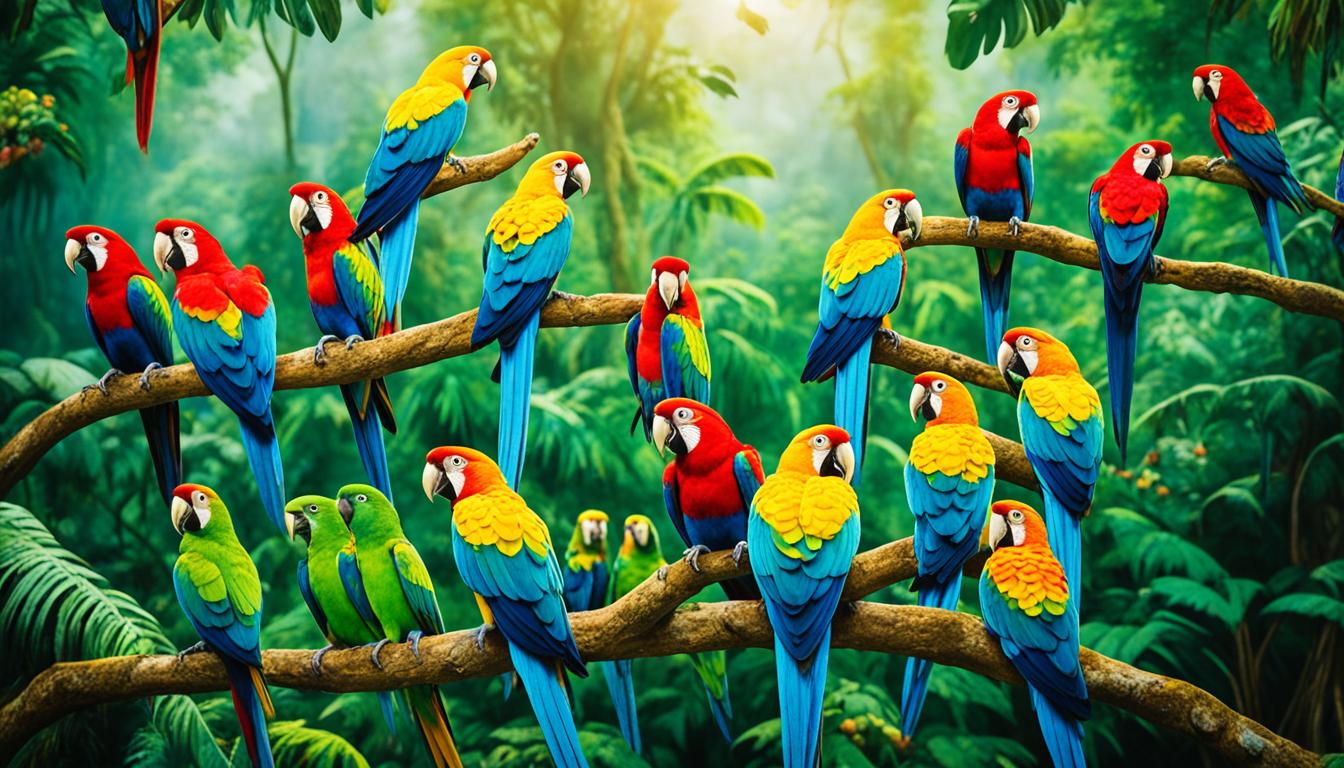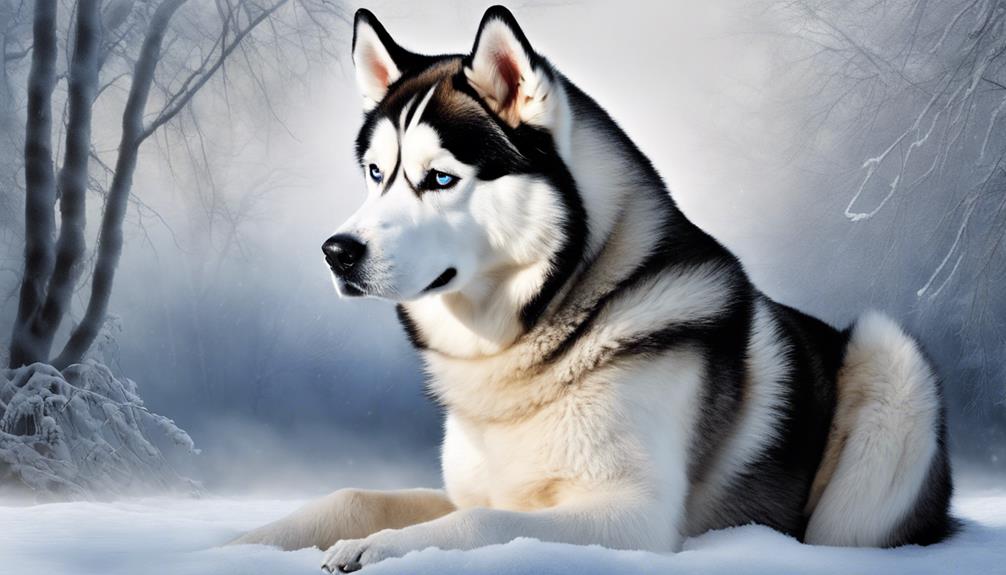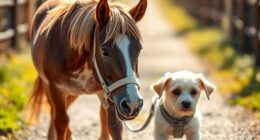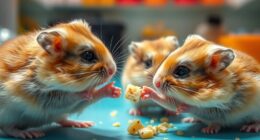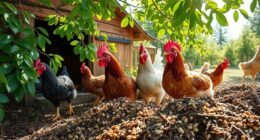No, raccoons are not bears. Even though they both belong to the Carnivora order, raccoons are in the Procyonidae family, separate from bears in the Ursidae family. Their genetic makeup influences their survival strategies and evolutionary paths, leading to distinct differences. Raccoons have bandit masks and are agile climbers, whereas bears lack these markings, relying on strength. Understanding these differences can help us appreciate the diverse species in the animal kingdom.
Key Takeaways
- Raccoons and bears are distinct species, belonging to different families within the order Carnivora.
- Raccoons have bandit masks, ringed tails, and are agile climbers, while bears lack these markings and exhibit strength.
- Bears have a plantigrade stance, while raccoons have a digitigrade or plantigrade stance.
- Raccoons scavenge in urban areas and are social, while bears forage in forests and are more solitary.
- The genetic makeup and evolutionary paths of raccoons and bears determine their taxonomic classification and behavioral differences.
Taxonomic Classification of Raccoons and Bears
Why do raccoons and bears belong to different taxonomic families despite both being part of the order Carnivora?
The answer lies in the intricate world of taxonomic classification. While both raccoons and bears fall under the umbrella of the Carnivora order, their genetic makeup places them in distinct families. Raccoons are members of the family Procyonidae, a group that includes species like coatis and ring-tailed cats. On the other hand, bears are classified in the family Ursidae, showcasing their unique evolutionary paths. Even though they share similarities as carnivores, the divergence in their genetic lineages over time led to their placement in separate families within the Carnivora order.
Understanding these taxonomic differences offers us a glimpse into the fascinating world of evolutionary biology. By delving into the family Procyonidae and Ursidae, we gain insights into the diverse genetic relationships present among species within the Carnivora order. This knowledge helps us appreciate the rich tapestry of life on Earth and the intricate connections that shape the animal kingdom.
Physical Differences Between Raccoons and Bears
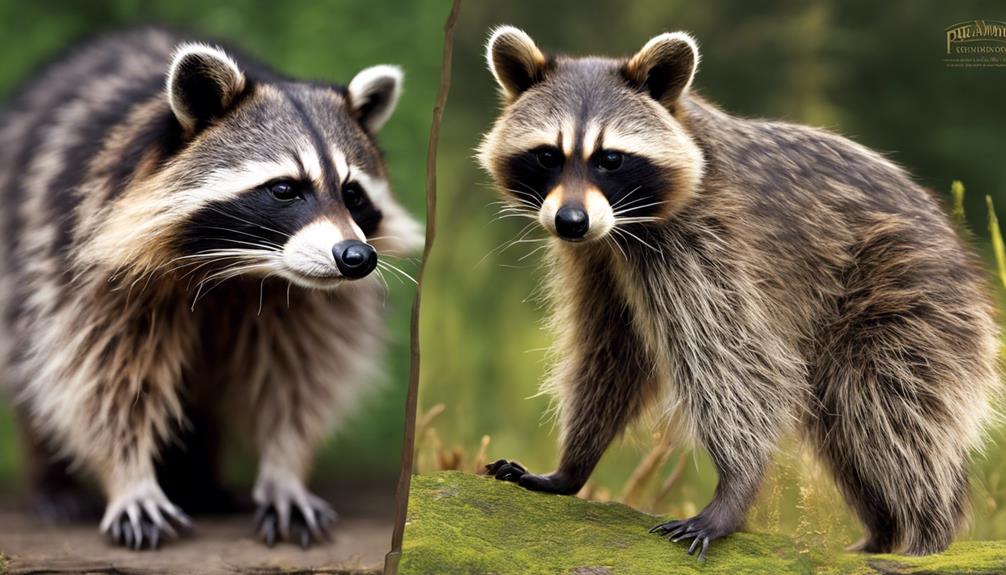
Comparing raccoons and bears, one immediately notices striking differences in their physical characteristics. Raccoons sport distinctive bandit masks around their eyes and long, ringed tails, while bears lack these markings and have shorter, bushy tails. Another notable contrast lies in their stance – bears have a plantigrade stance, meaning their flat feet touch the ground, whereas raccoons are either digitigrade or plantigrade, with only parts of their feet touching the ground.
When it comes to diet, bears have powerful jaws and teeth designed for crushing bones and tough plant material, whereas raccoons have a more omnivorous diet and a versatile set of teeth for grinding and tearing food. Moreover, raccoons are known for their agile climbing skills and dexterous front paws, while bears exhibit strength and endurance suited to their larger size and distinct ecological roles.
These differences in physical attributes showcase the unique adaptations of raccoons and bears to their respective environments.
Behavioral Contrasts: Raccoons Vs. Bears

Exhibiting distinct behavioral patterns, raccoons and bears showcase contrasting social interactions and foraging habits in their respective habitats.
- Raccoons are known for their scavenging behavior, often rummaging through trash cans in urban areas for food, displaying their adaptability to different environments. In contrast, bears primarily forage in forests and wilderness, relying on natural food sources like berries and fish.
- Bears tend to exhibit more solitary behavior, with some species being territorial, while raccoons are social animals that can live in small family groups, showcasing their ability to thrive in communal settings.
- Raccoons are excellent climbers with dexterous hands for manipulating objects, aiding them in scavenging for food efficiently. On the other hand, bears rely on their physical strength and powerful digging abilities to access food sources in their habitats.
- While bears hibernate during winter months to conserve energy, raccoons don't hibernate but may enter a state of torpor during extreme cold weather, highlighting their distinct survival strategies.
Habitat and Distribution Variances

Raccoons and bears occupy distinct habitats and display varying distribution patterns across different continents and ecosystems. Raccoons are primarily found in North and Central America, adapting well to wooded areas, wetlands, and even urban environments. On the other hand, bears have a broader distribution range, spanning across North America, Europe, Asia, and parts of Africa, inhabiting diverse ecosystems such as forests, mountains, and tundra. Unlike raccoons, bears tend to avoid heavily populated areas, showcasing different habitat preferences. Bears also exhibit larger home ranges, with some species like the polar bear covering extensive sea ice habitats.
To better understand the habitat and distribution variances between raccoons and bears, let's explore a comparative table below:
| Aspect | Raccoons | Bears |
|---|---|---|
| Habitat Preferences | Wooded areas, wetlands, urban areas | Forests, mountains, tundra |
| Distribution | Primarily in North and Central America | North America, Europe, Asia, parts of Africa |
| Behavior towards humans | Adapted to urban settings | Generally avoid heavily populated areas |
The habitat preferences and distribution patterns of these animals are closely tied to their ecological roles and evolutionary adaptations, influencing their environmental requirements and interactions within ecosystems.
Diet Variances: Raccoons Vs. Bears

Regarding dietary habits, bears and raccoons both demonstrate an omnivorous nature, yet their feeding behaviors and preferences exhibit notable distinctions.
- The diet consists of a variety of foods for both raccoons and bears, reflecting their common ancestor's omnivorous nature. However, raccoons have a more opportunistic approach, including human food scraps and raiding trash cans, while bears rely on a broader range of natural sources.
- Bears show a more diverse diet based on seasonal availability, with some species like polar bears leaning towards a more carnivorous diet, unlike raccoons that maintain a more consistent omnivorous approach.
- While both species are opportunistic feeders, bears generally have a wider dietary range compared to raccoons, incorporating berries, fish, insects, small mammals, plants, and sometimes scavenged meat.
- These dietary variances highlight the adaptability and evolutionary paths of raccoons and bears, showcasing how their feeding behaviors have diverged over time while still retaining elements of their shared omnivorous ancestry.
Interactions With Humans: Raccoons and Bears

In urban areas, raccoons often cross paths with humans due to their adaptability and scavenging behaviors. Bears, on the other hand, typically shy away from human interactions but can be lured by easily accessible food, leading to conflicts that pose risks to both parties.
Managing these encounters involves securing food sources, using bear-proof containers, and reducing attractants to foster peaceful coexistence between humans and wildlife.
Urban Encounters
Amidst urban landscapes, encounters with wildlife bring forth a unique blend of fascination and caution.
Raccoons, with their adaptability to human environments, are more commonly sighted in urban areas compared to bears.
Both raccoons and bears exhibit scavenging behavior around human habitation, but bears, being larger and stronger, pose a greater risk.
Bears may venture into urban areas seeking food, while raccoons often interact closely with human settlements, scavenging through trash bins for sustenance.
Urban encounters with bears can lead to wildlife management interventions to prevent conflicts, whereas raccoons are more inclined to coexist harmoniously with humans in urban settings.
Human-Wildlife Conflict
Encountering raccoons and bears in urban settings can lead to varying degrees of human-wildlife conflict, necessitating understanding their behaviors and implementing mitigation strategies for peaceful coexistence. When these animals venture into human-populated areas, conflicts may arise due to scavenging, property damage, and seeking food sources. To address these challenges, securing food sources, using deterrents, and wildlife-proofing measures are essential. Habituation to human presence can pose risks to both humans and wildlife, emphasizing the importance of learning about raccoon and bear habits. By comprehending their behaviors and taking proactive steps, we can minimize negative interactions and foster harmonious relationships with these fascinating creatures.
| Strategies for Mitigation | Raccoons | Bears |
|---|---|---|
| Securing food sources | Scavenging in urban areas | Foraging in human-populated areas |
| Using deterrents | Property damage | Damaging property |
| Wildlife-proofing measures | Raiding garbage bins | Seeking food sources |
Conservation Status of Raccoons and Bears

Raccoons and bears are both facing challenges in conservation efforts due to threats like habitat loss and human-wildlife conflicts. While raccoons are currently classified as a species of least concern, several bear species are listed as vulnerable or endangered.
Conservation initiatives aim to protect these animals by preserving their habitats and addressing conflicts to guarantee their survival in the wild.
Threats to Habitat
Facing numerous threats, both raccoons and bears are struggling to maintain suitable habitats essential for their survival.
- Habitat Loss: Raccoons are impacted by urbanization and deforestation, which reduce their natural living spaces.
- Habitat Fragmentation: Bears face challenges due to fragmented habitats, making it difficult for them to find suitable areas to thrive.
- Conservation Efforts: Efforts focus on preserving critical habitats like forests and wetlands to guarantee the survival of both species.
- Human-Wildlife Conflicts: Encounters with humans lead to challenges for raccoons and bears, affecting their ability to find safe environments.
These factors highlight the importance of conservation initiatives to protect the habitats of raccoons and bears, ensuring their populations remain stable and diverse.
Human-Wildlife Conflicts
Amidst the challenges of human-wildlife conflicts, both raccoons and bears navigate a complex landscape of habitat destruction and urbanization. Raccoons, part of the Procyonidae family, face these conflicts along with bears from the Ursidae family. Their distinct taxonomic classifications showcase their evolutionary differences.
While raccoons hold a status of least concern by the IUCN, various bear species range from vulnerable to critically endangered due to these conflicts. Conservation efforts for both species emphasize habitat protection, reducing human interactions, and combating issues like poaching and climate change.
Understanding the conservation status of raccoons and bears is critical for implementing effective management strategies to safeguard their survival and well-being in the wild.
Conservation Efforts
In managing the complex challenges of human-wildlife conflicts, both raccoons and bears require dedicated conservation efforts to secure their survival and well-being in the wild.
Conservation efforts for raccoons involve a focus on habitat protection to safeguard their diverse ecosystems and guarantee sufficient resources for their survival.
The Ursidae family, to which bears belong, faces global conservation challenges, with specific species like the polar bear being classified as vulnerable due to factors like climate change and habitat loss.
Implementing anti-poaching measures is vital in conservation initiatives for bears to combat illegal activities that threaten their populations.
Promoting coexistence strategies between humans and bears is essential to reduce conflicts and create harmonious relationships that benefit both species.
Frequently Asked Questions
What Kind of Animal Is a Raccoon?
A raccoon is a clever mammal with distinctive gray fur, wide faces, bandit masks, and ringed tails. They excel at climbing, possess high intelligence, and adapt well to different environments. Raccoons are known for their nocturnal habits and varied behaviors.
Are Raccoons Closer to Bears or Dogs?
I can share that raccoons are genetically closer to bears than to dogs, a fact supported by molecular analysis. Despite some physical resemblances to dogs, their evolutionary ties and genetic makeup align them more closely with bears.
What's the Closest Relative to a Raccoon?
In the animal kingdom, understanding the closest relative to a raccoon involves looking at genetic and evolutionary connections. Recent studies suggest raccoons share a common ancestor with bears, showcasing the intricate relationships within the Carnivora order.
What Is a Racoon Like Bear?
Curious minds ponder what a raccoon is like bear. While not bears, raccoons boast cleverness akin to a bear's resourcefulness. Evolution shaped us differently, yet we share nature's cunning ways in survival.
Are Raccoons Related to Bears in Any Way?
Yes, raccoons and bears are both part of the same taxonomic family, Ursidae. Despite this, raccoons are more closely related to the red panda than to mature bears. However, there are still some fascinating facts about mature bears that could surprise you.
Conclusion
To summarize, raccoons aren't bears, despite some physical similarities. Raccoons belong to the Procyonidae family, while bears are part of the Ursidae family. Raccoons are smaller in size, have distinct facial markings, and are more agile climbers compared to bears.
Understanding the differences in their taxonomy, behavior, habitat, diet, and interactions with humans is essential for proper conservation efforts. Remember, raccoons may look like tiny masked bandits, but they're unique creatures with their own important role in the ecosystem.



